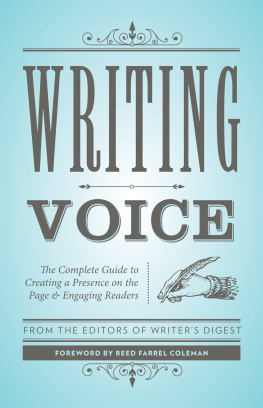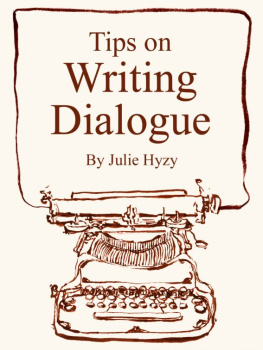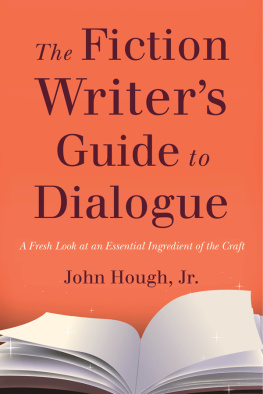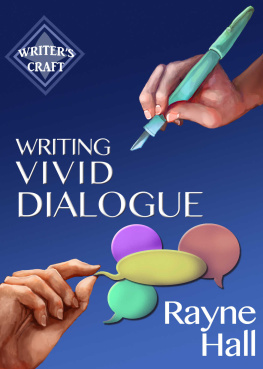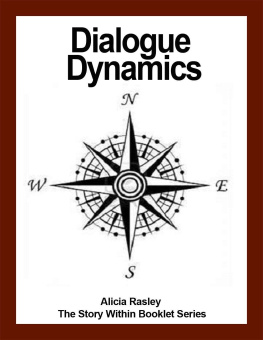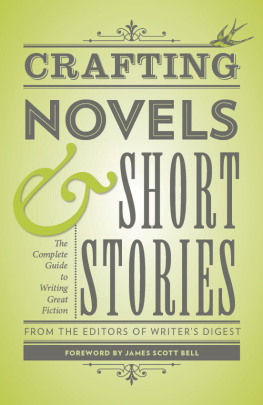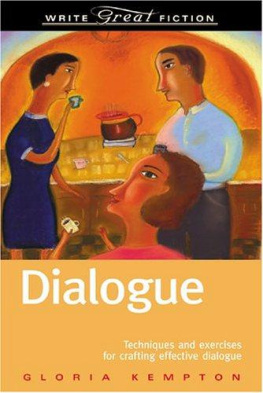Contents
Guide
Crafting Dynamic Dialogue
The Complete Guide to Speaking, Conversing, Arguing, and Thinking in Your Fiction
The Editors of Writers Digest
Cincinnati, Ohio
CRAFTING DYNAMIC DIALOGUE. Copyright 2016 by The Editors of Writers Digest. Manufactured in the United States of America. All rights reserved. No part of this book may be reproduced in any form or by any electronic or mechanical means including information storage and retrieval systems without permission in writing from the publisher, except by a reviewer, who may quote brief passages in a review. Published by Writers Digest Books, an imprint of F+W Media, Inc., 10151 Carver Road, Suite #200, Blue Ash, OH 45242. (800) 289-0963. First edition.
For more resources for writers, visit www.writersdigest.com .
Distributed in Canada by Fraser Direct
100 Armstrong Avenue
Georgetown, Ontario, Canada L7G 5S4
Tel: (905) 877-4411
Distributed in the U.K. and Europe by F&W Media International
Brunel House, Newton Abbot, Devon, TQ12 4PU, England
Tel: (+44) 1626-323200, Fax: (+44) 1626-323319
E-mail: ISBN-13: 978-1-4403-4554-8

WritersDigest.com
Cincinnati, Ohio
Part I
An Introduction to Dialogue
Chapter 1
He Said, She Said
Jack Smith
To write great fiction, you must be able to create complex, memorable characters, engaging plots, and vivid settings. You must also be able to create scenes that move, ones that arent labored or dull. Unless youre writing narrative scenes, this means handling dialogueand handling it well. When dialogue is rich with energy, characters come alive on the page. The various complexities of the human being are made manifest in what is stated, as well as what is left unsaidand in the apparent motives behind both speech and silence. It takes some doing to pull all of this off, but thats what it takes to write great dialogue.
The Process of Writing Dialogue
Like every other aspect of fiction writing, crafting strong dialogue calls for a process. For T.C. Boyle, award-winning author of fifteen novels and ten short story collections, this process is mostly an unconscious one. He doesnt intentionally set out to energize his dialogue. It just happens in its own energetic way, he says. Usually it rides along with me in the way that narration does. It all happens in the unconscious spell that overtakes a writer in the flow of composition. Novelist Amanda Filipacchi reports the same experience in drafting her dialogue. Its something that comes naturally to me and requires very little conscious effort or calculation.
Of course, plenty of authors prepare to write dialogue by doing some field work. Virgil Surez, author of several novels and story collections, regularly attunes himself to the various ways people speak. I like to eavesdrop on conversations, and there are plenty of contemporary places where you can go and do exactly that and no one would notice you sitting there taking it all in. But when it comes to the actual writing, for Surez this is largely intuitive: It comes in a variety of ways, sometimes even in sleep. I also hear it as I am writing. The lines that come to me often evolve out of a characters need to speak, to be heard. It also comes from watching characters move from scene to scene. What would they say to themselves?
All this is nonrational, a matter of feel. And yet Surez has noticed a set of consistent features that energize his dialogue. Banter is an important one. I am a big believer in banter between characters as it is a way to create dynamic tension through the way the characters speak. Surez also plays with the margins between silence and sound. Always present is the idea that silence is often much better for drama than dialogue itself. I like to punctuate my scenes with lots of quiet banter and have plenty of second-level (daily life noise) action going on in the background. My characters never speak in a vacuum; theres always something going on either in their minds or in their setting.
Notice the repartee in Surezs short story Blown, from his collection The Soviet Circus Comes to Havana.
I bet you didnt know I was in Vietnam, you say.
A Cuban in Vietnam?
You notice how her fingers shake as she takes a cigarette out of the YSL Ritz pack.
When the time came, everybody went, you say.
Not everybody.
You were here? you ask.
Cuba, she says and looks at the man playing the electric piano. He jumps up and down as he starts his solo.
Like I said, I went.
All right, she says. How many did you kill?
I got there at the end. Before I knew it I was back.
Thats anti-climactic.
So what?
Clipped, playful dialogue. Note the man about to gyrate on the electric piano. Banter, silence, soundthese elements tend to pattern Surezs dialogue, elements ingrained after years of writing, modulated to meet the needs of each new story or novel. Its his stamp of originality.
Originality is also important to Filipacchi, and for her, this means avoiding the predictable. Dialogue that foils readers expectations, even in small and subtle ways, can arouse your readers curiosity and make them pay closer attention. Misunderstandings and misinterpretations between characters can bring entertainment and stress to the readertwo forms of beneficial energy in fiction.
The more you write dialogue, the more you just let it happen, listening to your characters speak, you will probably discover your own distinctive approach: energized by the beat or rhythm of your characters words, their utterances as well as silences, their back-and-forth, their complex, rich voices. Let loose your imagination, your intuitive side. Dont engineer your dialogue. If you force anything, it will come off as fake and inauthentic.
And yet there is always revision. Rethinking, redoing. Like every other element in fiction, you must, at some point, turn a critical eye to your dialogue and demand more of it. Does it reveal character? Does it reveal conflict? Will it keep the readers interest?
For award-winning short story writer Laura van den Berg, revision strategies come down to several key questions: Where is the tension? Where is the arc? What is happening underneath the surface? As she reviews her dialogue, van den Berg pays special attention to this latter issue. Its crucial to think about whats crackling beneath the surfacewhere is the subtext? The layers? What is the end game for this conversation for the narrator? What does she want in this moment? These under-layers are a huge part of what brings energy to dialogue.
Notice whats crackling beneath the surface in van den Bergs story I Looked for You, I Called Your Name, from her collection The Isle of Youth. Here the narrator, on a honeymoon in Patagonia, is plagued by a series of disastersfor starters a broken nose when their plane makes an emergency landing. You cant help but sense an under-layer in the honeymooning couples conversation with another newly married couple. The narrator replies to a comment about being just recently married.
Yes, I said. I suppose we are. I felt as though I was hovering just above the ground. I hooked myself around my husbands elbow. But doesnt it feel like its been ages? I said. Ages and ages and ages?


